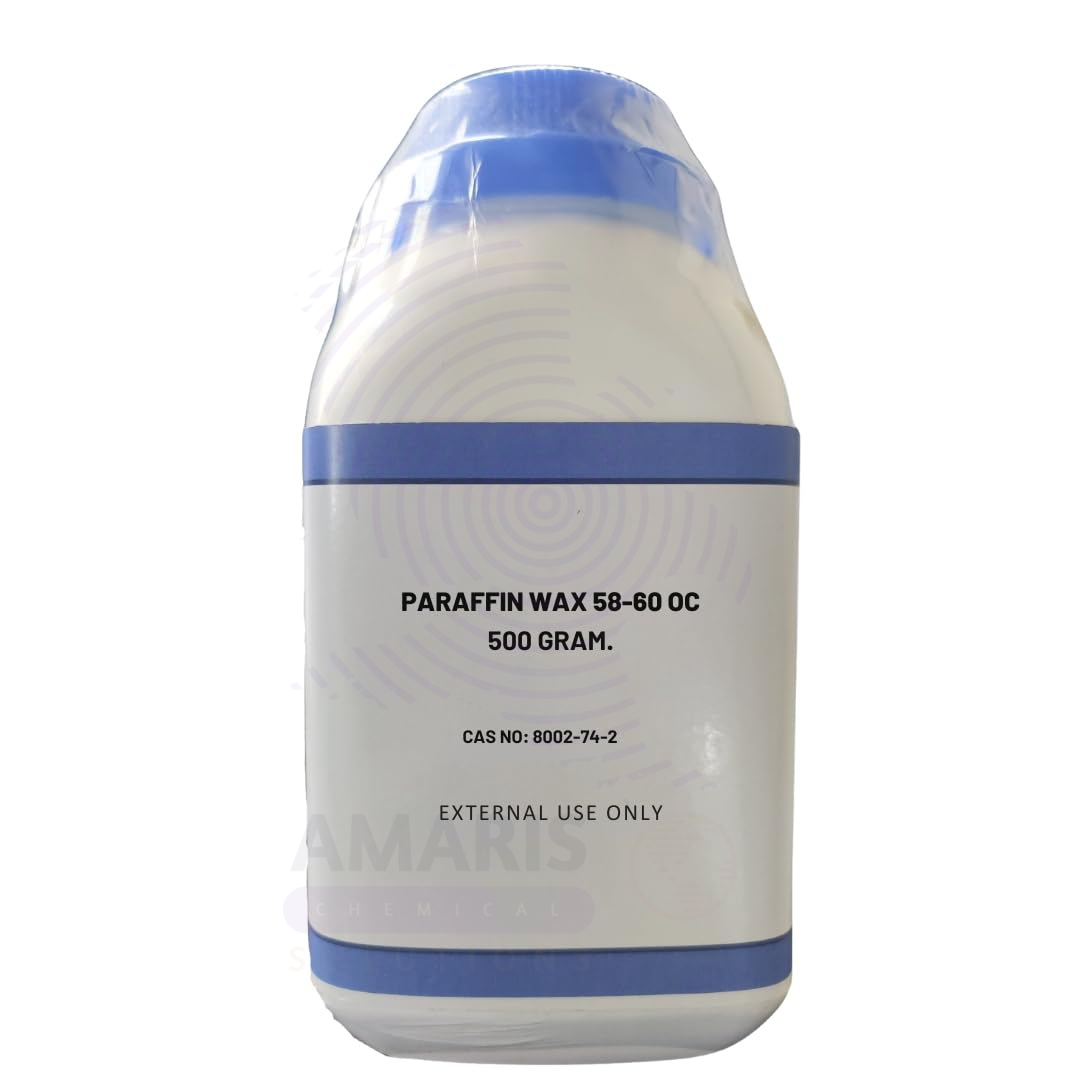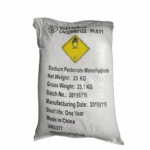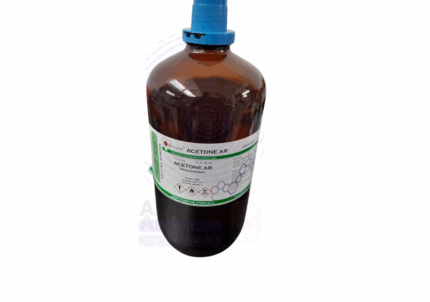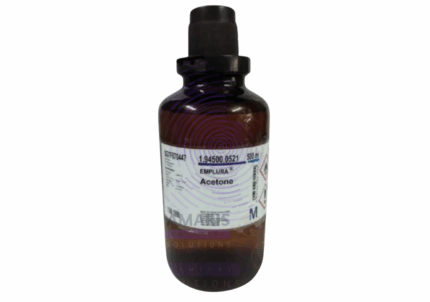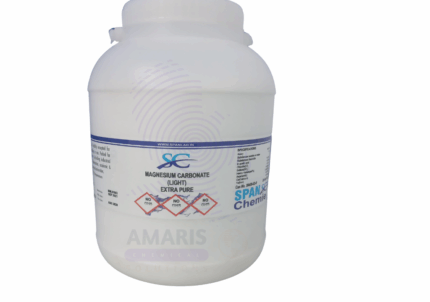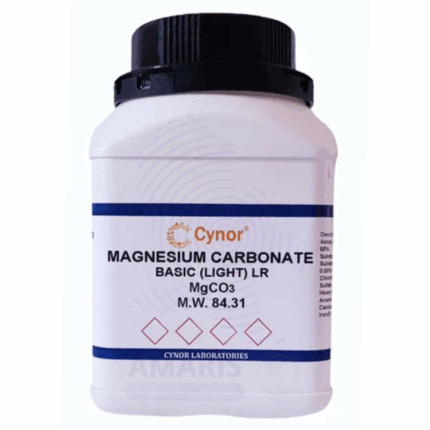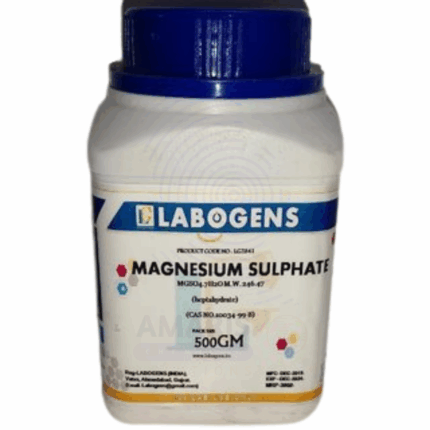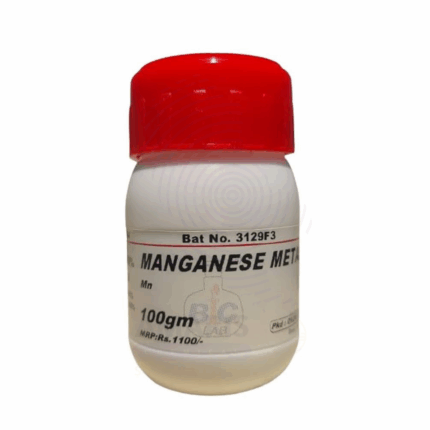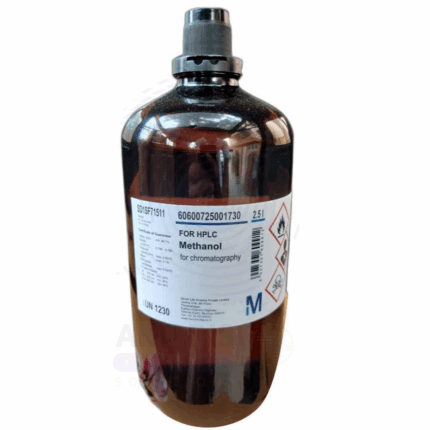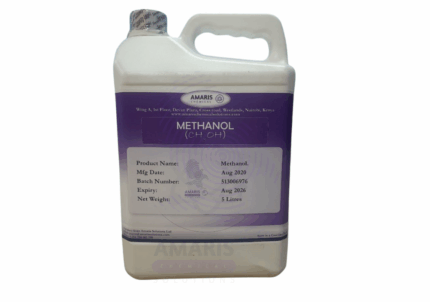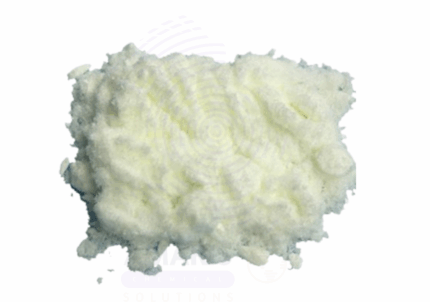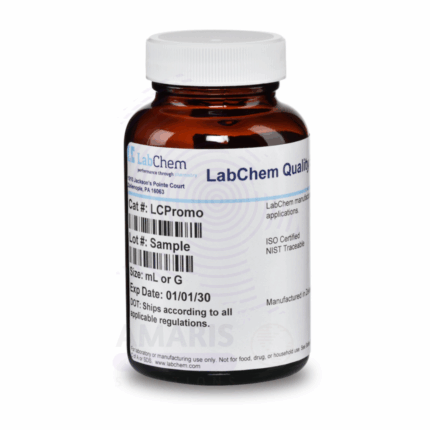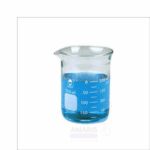
Paraffin Wax Extra Pure
$ 7.00 Original price was: $ 7.00.$ 6.98Current price is: $ 6.98.
Paraffin Wax Extra Pure is a refined, high-purity hydrocarbon compound derived from petroleum. It appears as a white, odorless, and tasteless solid with a smooth, waxy texture and a relatively low melting point, making it easy to mold and blend with other substances.
This Extra Pure grade is especially suited for laboratory use, cosmetic formulations, pharmaceutical applications, and specialized industrial processes. It is commonly employed in the preparation of ointments, candles, sealing agents, and coating materials due to its excellent insulating, water-repellent, and moisture-barrier properties. Its chemical inertness also makes it a safe choice for embedding biological samples and for use as a lubricant or mold-release agent. Paraffin Wax should be stored in a cool, dry place, away from heat sources, and handled with care to prevent unwanted melting or contamination.
Paraffin Wax Extra Pure
Primary Uses
- Waterproofing and Sealing Agent
- Used to impregnate and coat materials like paper and cardboard to create moisture-resistant packaging for food (e.g., milk cartons, wax paper) and other hygroscopic goods. It is also used to seal jars, preserves, and bottles.
- Fuel and Combustible Material in Candles
- Serves as the primary raw material for candle production. Its high purity ensures a clean, consistent burn with minimal smoke or odor, making it ideal for household, decorative, and religious candles.
- Lubricant and Mold Release Agent
- Applied as a dry lubricant on surfaces like drawers, zippers, and tools to reduce friction. In manufacturing, it is used as a release agent to prevent materials (e.g., concrete, gypsum, polymers) from sticking to molds.
- Thermal Energy Storage Phase Change Material (PCM)
- Utilized in thermal management systems because it melts and solidifies at a specific, consistent temperature, absorbing and releasing large amounts of latent heat. It is incorporated into wallboards, solar heating systems, and temperature-controlled packaging.
Secondary Uses
- Impregnation and Preservation Agent
- Used to impregnate matches to control the burn rate of the matchstick. It is also used in museums and archaeology to preserve and strengthen water-logged or fragile organic materials (like wood or leather) by displacing water with wax.
- Base for Cosmetics and Ointments
- Acts as a key ingredient in cosmetic formulations such as lip balms, cold creams, and lotions to provide structure, increase hardness, and create a protective barrier on the skin. It is also a base for petroleum jelly and therapeutic ointments.
- Electrical Insulator
- Employed to impregnate or coat electrical components like capacitors and transformer windings, as well as to seal battery terminals, due to its excellent dielectric properties and resistance to moisture.
- Teaching Tool in Crystallography and Material Science
- Serves as an excellent, safe material for demonstrating crystalline structure formation, phase changes (melting/freezing), and the properties of hydrocarbons in an educational laboratory setting.
KEY ATTRIBUTES
1. Basic Identification Attributes
- Chemical Name: Paraffin Wax
- CAS Number: 8002-74-2
- HS Code: 2712.20.00
- Molecular Formula: Approx. CₙH₂ₙ₊₂ (mixture of alkanes, typically C20–C40)
- Synonyms:
- Hard wax
- Petroleum wax
- Fully refined paraffin
- Microcrystalline wax (related but distinct)
2. Physical & Chemical Properties
- Physical State: Solid (waxy)
- Color & Odor: White or colorless; faint petroleum-like odor
- Melting Point: 46–68 °C (varies by grade)
- Boiling Point: >300 °C (decomposes)
- Density: ~0.9 g/cm³ at 20 °C
- Solubility:
- Insoluble in water
- Soluble in ether, benzene, chloroform, oils
- pH Level: Not applicable (non-aqueous solid)
- Vapor Pressure: Negligible at room temperature
- Flash Point: ~199 °C (closed cup)
- Autoignition Temperature: ~245 °C
- Viscosity: Low when melted; varies by molecular weight
3. Safety & Hazard Attributes
- Hazard Class (GHS Classification):
- Not classified as hazardous under GHS for standard forms
- May cause mechanical irritation if inhaled as fumes or dust
- NFPA Ratings:
- Health: 1
- Flammability: 1
- Reactivity: 0
- Exposure Limits:
- OSHA PEL (Particulates Not Otherwise Regulated): 15 mg/m³ (total dust)
- ACGIH TLV: Not specifically listed
- Reactivity:
- Stable under normal conditions
- Avoid open flames and strong oxidizing agents
4. Storage & Handling Attributes
- Storage Conditions:
- Store in a dry, cool, well-ventilated area
- Avoid temperatures near melting point to prevent deformation
- Incompatible Materials:
- Strong oxidizers (e.g., chlorine, oxygen under pressure)
- Container Type: Plastic-lined cartons, polyethylene bags, metal drums
- Shelf Life & Expiration Date: Indefinite under proper storage
- Special Handling Requirements:
- Use protective gloves and goggles when handling molten wax
- Provide ventilation during melting or heating
5. Regulatory & Compliance Attributes
- Regulatory Status:
- Listed in TSCA, REACH
- FDA-approved for food-contact applications (specific grades)
- Hazard Symbols (GHS Pictograms):
- Not required for solid, non-hazardous form
- Transportation Restrictions:
- Not regulated for transport (non-hazardous)
- Waste Disposal Method:
- Can be disposed of as non-hazardous solid waste
- Follow local environmental regulations
6. Environmental & Health Impact
- Ecotoxicity:
- Low toxicity to aquatic and terrestrial organisms
- Persistence in Environment:
- Slowly biodegradable; may persist in soils or water
- Carcinogenicity/Mutagenicity:
- Not classified as carcinogenic by IARC or OSHA
- No mutagenic effects known
- Biodegradability:
- Slowly biodegradable under certain environmental conditions
SAFETY PRECAUTIONS
Personal Protective Equipment (PPE):
- Wear a lab coat, heat-resistant gloves (if handling molten wax), and safety goggles.
- Use a dust mask or ensure good ventilation if heated or processed.
Handling:
- Handle with care to avoid spills and splashes.
- Avoid inhalation of vapors or fumes when heated.
- Do not overheat to avoid thermal decomposition.
- Wash hands after handling.
Storage:
- Store in a cool, dry, and well-ventilated area.
- Keep the container tightly closed.
- Protect from open flames, high heat, and direct sunlight.
- Keep away from oxidizing agents.
FIRST AID MEASURES
Inhalation:
- Move the person to fresh air.
- If respiratory symptoms occur, seek medical advice.
Skin Contact:
- For solid wax: Wash with soap and water.
- For molten wax: Cool affected area with water, do not remove wax forcibly.
- Seek medical attention for burns or irritation.
Eye Contact:
- Rinse cautiously with water for several minutes.
- Remove contact lenses if present and easy to do.
- Seek medical attention if irritation persists.
Ingestion:
- Rinse mouth with water.
- Do not induce vomiting.
- Seek medical attention if symptoms occur.
FIRE FIGHTING MEASURES
Flammability:
- Combustible solid—can catch fire at high temperatures.
Extinguishing Media:
- Use dry chemicals, CO₂, or foam.
- Do not use a direct water jet on molten wax—it may cause splattering.
Hazardous Combustion Products:
- May emit carbon monoxide and carbon dioxide when burned.
Firefighter Protection:
- Wear self-contained breathing apparatus (SCBA) and full protective gear.


 Preservatives(food)
Preservatives(food) Flavor Enhancers
Flavor Enhancers Acidulants
Acidulants Sweeteners
Sweeteners Antioxidants
Antioxidants Colorants(food)
Colorants(food) Nutraceutical Ingredients (food)
Nutraceutical Ingredients (food) Nutrient Supplements
Nutrient Supplements Emulsifiers
Emulsifiers
 Collectors
Collectors Dust Suppressants
Dust Suppressants Explosives and Blasting Agents
Explosives and Blasting Agents Flocculants and Coagulants
Flocculants and Coagulants Frothers
Frothers Leaching Agents
Leaching Agents pH Modifiers
pH Modifiers Precious Metal Extraction Agents
Precious Metal Extraction Agents
 Antioxidants(plastic)
Antioxidants(plastic) Colorants (Pigments, Dyes)
Colorants (Pigments, Dyes) Fillers and Reinforcements
Fillers and Reinforcements Flame Retardants
Flame Retardants Monomers
Monomers Plasticizers
Plasticizers Polymerization Initiators
Polymerization Initiators Stabilizers (UV, Heat)
Stabilizers (UV, Heat)
 Antifoaming Agents
Antifoaming Agents Chelating Agents
Chelating Agents Coagulants and Flocculants
Coagulants and Flocculants Corrosion Inhibitors
Corrosion Inhibitors Disinfectants and Biocides
Disinfectants and Biocides Oxidizing Agents
Oxidizing Agents pH Adjusters
pH Adjusters Scale Inhibitors( water)
Scale Inhibitors( water)
 Antioxidants(cosmetic)
Antioxidants(cosmetic) Emollients
Emollients Fragrances and Essential Oils
Fragrances and Essential Oils Humectants
Humectants Preservatives
Preservatives Surfactants(cosmetic)
Surfactants(cosmetic) Thickeners
Thickeners UV Filters
UV Filters
 Fertilizers
Fertilizers Soil Conditioners
Soil Conditioners Plant Growth Regulators
Plant Growth Regulators Animal Feed Additives
Animal Feed Additives Biostimulants
Biostimulants Pesticides (Herbicides, Insecticides, Fungicides)
Pesticides (Herbicides, Insecticides, Fungicides)
 Active Pharmaceutical Ingredients (APIs)
Active Pharmaceutical Ingredients (APIs) Excipients
Excipients Solvents(pharmaceutical)
Solvents(pharmaceutical) Antibiotics
Antibiotics Antiseptics and Disinfectants
Antiseptics and Disinfectants Vaccine Adjuvants
Vaccine Adjuvants Nutraceutical Ingredients (pharmaceutical)
Nutraceutical Ingredients (pharmaceutical) Analgesics & Antipyretics
Analgesics & Antipyretics
 Analytical Reagents
Analytical Reagents Solvents(lab)
Solvents(lab) Chromatography Chemicals
Chromatography Chemicals Spectroscopy Reagents
Spectroscopy Reagents microbiology-and-cell-culture-reagents
microbiology-and-cell-culture-reagents Molecular Biology Reagents
Molecular Biology Reagents Biochemical Reagents
Biochemical Reagents Inorganic and Organic Standards
Inorganic and Organic Standards Laboratory Safety Chemicals
Laboratory Safety Chemicals Specialty Laboratory Chemicals(Special Laboratory Equipment)
Specialty Laboratory Chemicals(Special Laboratory Equipment)
 Demulsifiers
Demulsifiers Hydraulic Fracturing Fluids
Hydraulic Fracturing Fluids Scale Inhibitors(oil)
Scale Inhibitors(oil) Surfactants(oil)
Surfactants(oil) Drilling Fluids
Drilling Fluids
 Dyes and Pigments
Dyes and Pigments Bleaching Agents
Bleaching Agents Softening Agents
Softening Agents Finishing Agents
Finishing Agents Antistatic Agents
Antistatic Agents
 Admixtures
Admixtures Waterproofing Agents
Waterproofing Agents Sealants and Adhesives
Sealants and Adhesives Curing Compounds
Curing Compounds Concrete Repair Chemicals
Concrete Repair Chemicals Anti-Corrosion Coatings
Anti-Corrosion Coatings
 Surfactants(cleaning)
Surfactants(cleaning) Builders
Builders Enzymes
Enzymes Solvents (Cleaning)
Solvents (Cleaning) Fragrances
Fragrances
 Electronic Chemicals
Electronic Chemicals Catalysts
Catalysts Lubricants
Lubricants Photographic Chemicals
Photographic Chemicals Refrigerants
Refrigerants Automotive chemicals
Automotive chemicals Pyrotechnic Chemicals
Pyrotechnic Chemicals
 Biodegradable Surfactants
Biodegradable Surfactants Bio-based Solvents
Bio-based Solvents Renewable Polymers
Renewable Polymers Carbon Capture Chemicals
Carbon Capture Chemicals Wastewater Treatment Chemicals
Wastewater Treatment Chemicals
 Pigments
Pigments Solvents(paint)
Solvents(paint) Specialty Coatings
Specialty Coatings Binders/Resins
Binders/Resins Additives
Additives Driers
Driers Anti-Corrosion Agents
Anti-Corrosion Agents Functional Coatings
Functional Coatings Application-Specific Coatings
Application-Specific Coatings
 Fresh Herbs
Fresh Herbs Ground Spices
Ground Spices Whole Spices
Whole Spices Spice Blends
Spice Blends Dried Herbs
Dried Herbs
 Leavening Agents
Leavening Agents Dough Conditioners
Dough Conditioners Flour Treatments
Flour Treatments Fat Replacers
Fat Replacers Decoratives
Decoratives Preservatives(baking)
Preservatives(baking)
 Plasticizers & Softeners
Plasticizers & Softeners Reinforcing Agents
Reinforcing Agents Adhesion Promoters
Adhesion Promoters Vulcanizing Agents
Vulcanizing Agents Antidegradants
Antidegradants Blowing Agents
Blowing Agents Fillers & Extenders
Fillers & Extenders Accelerators & Retarders
Accelerators & Retarders